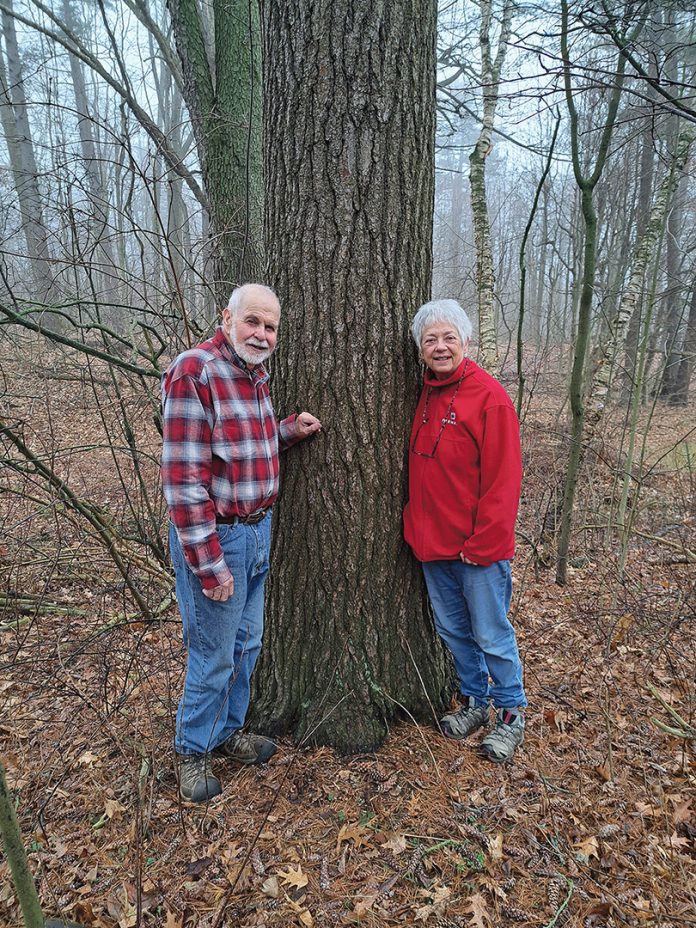Along the shore of Lake Ontario in a small section of Whitby, centuries-old white pine trees loom 100 feet high. Many birders and nature enthusiasts know the area to be a hotspot of animal activity, but the woods are noteworthy for more than just birdwatching.
Thickson’s Woods is an old-growth forest: an ecosystem that can sustain extremely old and large trees. Most forests in developed areas are very young comparatively.
Dennis Barry and Margaret Carney recognized the importance of this forest back when it was only considered useful for its lumber more than 40 years ago.
“We moved here in 1980, and the question was always, ‘Is the woods protected?’ And everybody said, ‘Yeah, it’s protected,’ including the realtor,” Carney says. According to Carney, the owner of the property was a developer who wanted to build condos on the land. The plan was denied because the access roads weren’t wide enough.
In 1983, the couple was shocked when they discovered that the forest was not protected as they had been assured. Carney explains that the logging rights were sold to a company that cut down 60 white pines over the course of a few days.
“I’m always going to cry when I say this,” she says, already tearing up as she reminisces on the day of the tree harvest. “I was working at home that day, and I got very little done because every 15 minutes the house would shake as one of these trees came down.”
Since then, Barry and Carney worked hard to protect the remaining old-growth trees, as well as all the other species that call the woods home. Through fundraising efforts, they managed to buy the land from developers over five years.
Now, the Thickson’s Woods Land Trust oversees more than 16 acres of forest and eight acres of the adjacent meadow, maintaining trails, conducting ecological surveys, and getting rid of invasive species. These woods are home for Barry and Carney, as familiar to them as their house that sits on the edge of the tree line.
On a misty spring day, Barry walks through the forest equipped with binoculars, pointing out the various trees and birds. He identifies a black cherry tree by touch, running his hands over the rough bark. A cardinal calls overhead, and he recognizes the song. He spots small birds hiding from predators in the hawthorn bushes. It’s difficult to see much through the fog, but he keeps his eyes peeled for any sign of the two great horned owls that make their home in the woods.
Although the patch of land is relatively small, it’s abundant with wildlife. To date, there have been over 1200 species of moths, more than 300 bird species, and several mammal species found within these 25 acres, according to ecological surveys conducted by the Matt Holder Environmental Research Fund.
Barry explains this wide variety of species can live here because Thickson’s Woods consists of several different ecosystems – the old growth forest, lakefront habitat, shrubby meadow, and a marsh with mudflats.
“So that’s what’s important,” he says. “The fact that it’s small is not as important.”
Kathy Lutrell is the senior natural heritage ecologist at CLOCA. She explains that although the goal is to conserve as much land as possible, small areas like Thickson’s Woods make a big difference for wildlife, especially because of where it’s situated.
“In this particular location, we have an otherwise very urban and very industrial landscape. And it’s right along the north shore of Lake Ontario, which is an important wildlife movement corridor in this location as well.”
This idea has been gaining traction in recent years. Nature patches in urban cities are becoming increasingly popular, especially in places where larger conservation areas aren’t possible. In Durham Region, urban forest initiatives are already happening.
The town of Whitby has partnered with Local Enhancement and Appreciation of Forests (LEAF) to encourage residents to plant more native trees in their neighbourhoods. According to LEAF, having diverse species of trees in urban areas comes with numerous benefits, including improved air quality, lowered household energy consumption, and reduced noise pollution.
Lutrell explains these initiatives are particularly important in Durham Region.
“If you look at the broader landscape on the whole, we have intense urbanization and the provincial goals are to intensify even more,” she says. “So, when that happens, these smaller pockets become even more important, because the wildlife need refuge. They need places to go.”
Barry and Carney have seen the importance of these spaces first-hand. Reflecting on that day when the logging company cut the old-growth trees, Carney says the drive to stop the destruction will stay with her forever.
“It was horrible. It was awful. So, it was good motivation to spend the next 40 years taking care of the woods, which happened to be in our backyard. Quite wonderful.”




